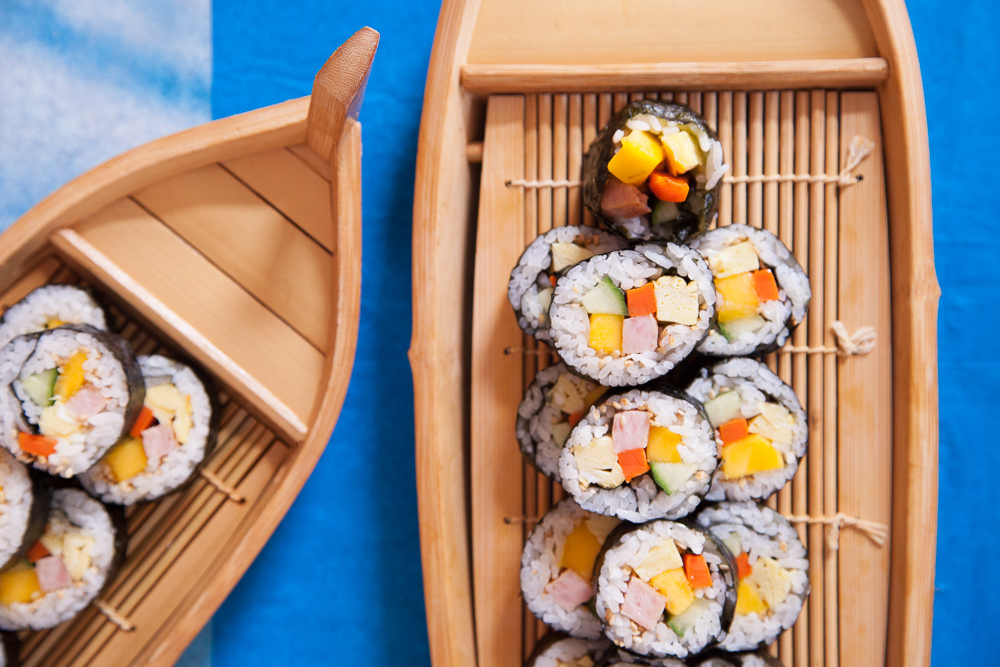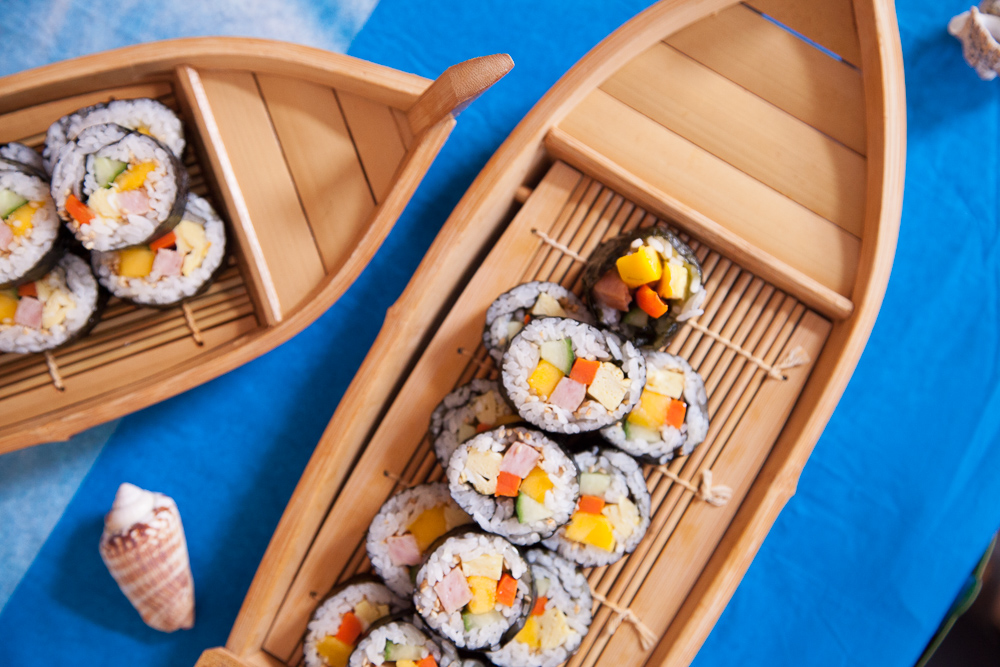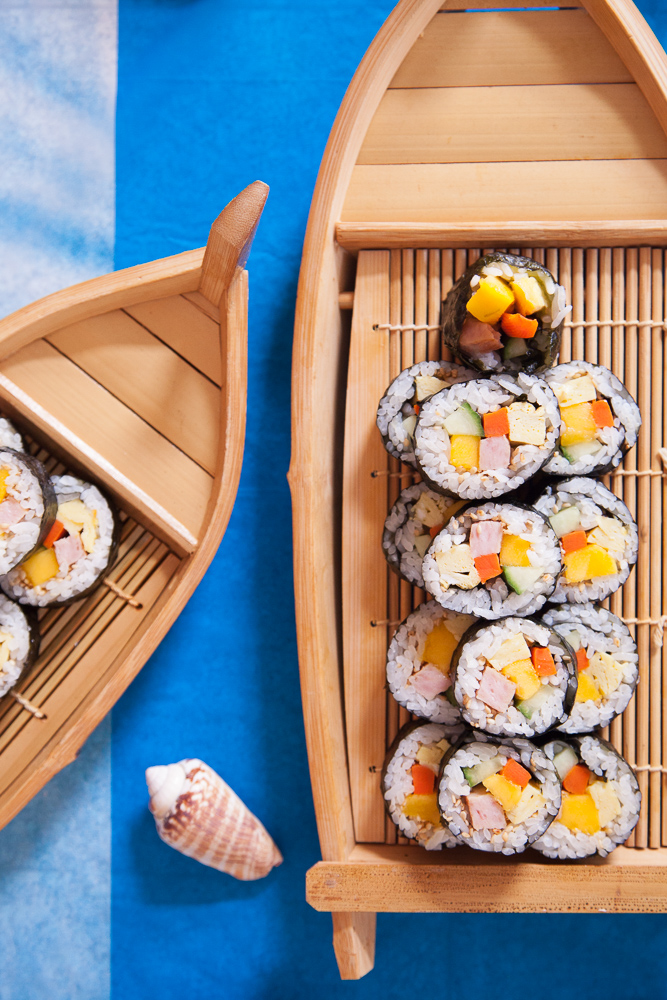Kimbap: Korean Seaweed Rolls
Growing up in California, my Korean mother used to make kimbap (김밥) for my school lunch. Every week and sometimes even every day, my friends would look for me during lunch time, asking if she packed these homemade rolls. I happily shared the tasty creations and told my mother how much my classmates enjoyed her kimbap. She was delighted yet also concerned I wasn’t eating enough as I was giving away more than half my lunch. She came up with an idea: every Friday she would pack me extra rolls to share with friends. I spread the yummy news and was hunted down every Friday for the rest of my high school career. Whoever said, “There’s no such thing as a free lunch,” didn’t know about the Friday special!
When Mommy Oh was preparing kimbap rolls for a recent birthday event, I captured the process. She’s not the measuring type, but I’ve asked her for the details so the rest of us can replicate as closely possible to this particular recipe.
My mother has variations of kimbap. The kind she made for me in high school differs from this post. For example, the Friday Rolls would have sesame oil brushed on the exterior for an extra cozy, nutty flavor. The version I’m sharing with you today was for a luau-themed birthday party, thus my mother switched out the danmuji (pickled yellow radish) with a sweetly ripened mango. She was aiming for tropical vibes.
Common kimbap ingredients include bulgogi, spinach, egg, cucumber, carrot, imitation crab meat, burdock root and kimchi. The beauty of kimbap rolls: you can customize them with your preferred ingredient. As long as you can roll them up into smooth cylinders, stuff them with whatever makes your heart sing~
Note: Some refer kimbap as “Korean sushi.” Sushi is famous for using seafood. The typical kimbap does not use raw fish, rather focuses on vegetables and land meat (ie: beef & egg). As with many other dishes around the world, the origin of kimbap is argued. Some say the Koreans invented it. Some say it was the Chinese. Others believe kimbap appeared in Korea during the Japanese colonial period. It is also said the concept of sushi comes from South East Asia. While people get territorial about where kimbap (and rolls in general) come from, let’s run away with the rolls and eat them all! Point being, there has been cultural import and export throughout the history of humankind. And guess what? Our seven continents used to be one super continent.
Now let’s rock n roll!
INGREDIENTS
4 cups cooked white rice
7 sheets of dried seaweed
1 can of Spam
1 medium to large carrot
1 cucumber
3 eggs
1 ripe mango
sesame seeds
sesame oil
Serving: Depends on your appetite. For some, one roll makes one serving. Others may eat four rolls in one sitting. My mother made 7 rolls with 4 cups of white rice. The more rice you add in each roll, the less rolls you’ll get. If you prefer stronger flavors, add in less rice per roll.
Step 1
Cook the white rice. Be sure it is not soggy. Let the rice cool down.
Step 2
Pan-fry the Spam. As it already contains oil, there is no need to add more. Dab the excess oil with paper towel. Once cooked and cooled, cut into long strips.
Step 3
Julienne the carrot. Pan-fry with a tad of olive oil and a pinch of salt.
Step 4
Scramble your eggs and pan-fry into a flat form. Cut into long strips.
Cut the raw cucumber into long strips.
Step 5
As mentioned in the intro, my mother used a ripe mango instead of danmuji (pickled yellow radish) as the rolls were for a luau-themed party. Cut the mango into long slices.
How thinly you cut your ingredients is a style choice. Once you cut the rolls and peer into the cross-section, the ingredients’ shape inside may look simple or complex. Depends on you. For beginners, thicker cuts will be easier to assemble prior to rolling the kimbap. I suggest the slices to be less than 1cm x 1cm thick.
Step 6
Grab a sheet of dry seaweed. Spread an even layer of rice, leaving about 1/5 of the top empty.
Step 7
Place a row of each ingredient across the rice in the middle. Allow the ingredients to slightly go beyond the seaweed perimeter. In this case, we have cucumber, carrot, spam, egg and mango. For a saltier flavor, add more spam. For more sweetness, add in more mango. My mother also sprinkled sesame seeds on the ingredients. You can also use black sesame seeds to add another layer of color.
Step 8
Take a couple grains of rice. Gently spread it across the top area of the seaweed (where we left 1/5 of it blank). This will act as glue, keeping the kimbap slices together after you roll them up.
Step 9
Lifting from the bottom of your seaweed, start rolling. From the side profile, a circular shape will form. You can use a bamboo roller or roll directly with your hands. The bamboo roller will be a great help for those making kimbap for the first time.
Step 10
Once you create the cylinder, you can squeeze the ends like my mother does. Not too tight, otherwise your kimbap will explode.
At this point, you can brush on a layer of sesame oil onto the seaweed. The sesame oil will add a nutty taste.
Street food stalls in Korea also sprinkle on a generous amount of sesame seeds on top of the sesame oily exterior. For those who prefer to taste more of the seaweed, skip the sesame oil.
Step 11
Time to cut the cylinder into bite-sized slices! Preferably with a thin sharp knife. If it’s a challenge cutting the kimbap, carefully dab on sesame oil at the edge of the knife.
Step 12
All there is left to do is invite your buddies over and munch out! Or you can keep the edible secrets to yourself. Whichever way you ROLL, hope you enjoyed this post and the puns.
It’s time for the kimbap to sail away!
Thanks, Mommy Oh
…for sharing your recipe with us! I look forward to seeing how the sesame oily Friday Rolls are made in the future.



















